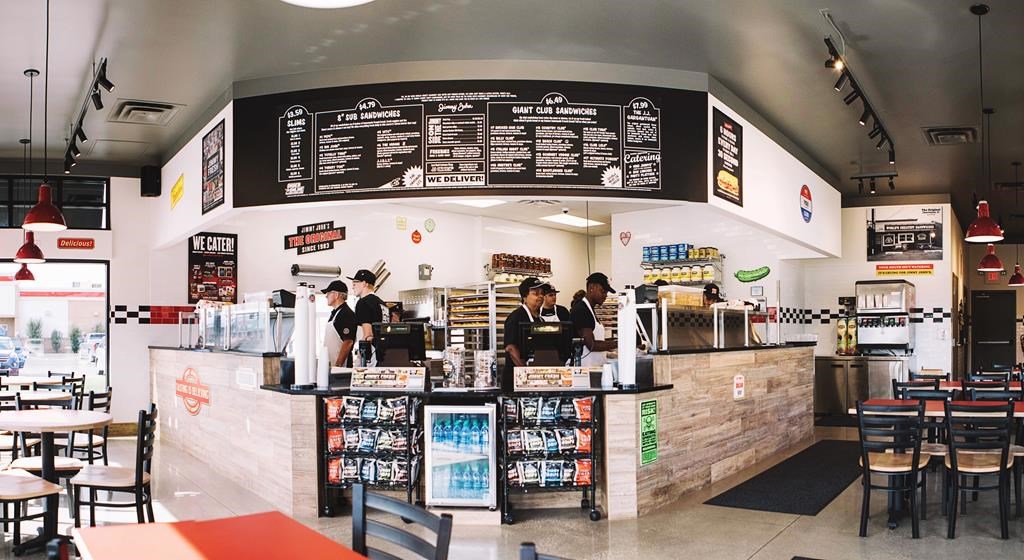A battle of the sandwich brands is materializing as a pair of U.S. sub companies announce big plans for Canada.

Inspire Brands announced Wednesday that its Jimmy John’s banner would use a franchise model to make its way outside the U.S. this year with a restaurant in the Greater Toronto Area and more to follow across the country.
Meanwhile, Redberry Restaurants said its Jersey Mike’s Subs brand, which already has two locations in Ontario, plans to open more than 300 Canadian restaurants by 2034. Some will be franchises, others owned by Redberry, which owns and operates more than 180 Burger King and Taco Bell locations.
Both companies are known for their customizable submarine-style sandwiches, which are served with sides like chips and cookies. At Jimmy John’s, diners can also opt for wraps or an unwich, a sandwich which uses lettuce in lieu of a bun. Jersey Mike’s says its subs are Northeast-style, feature fresh-sliced meat and can be topped with “the juice,” a blend of red wine vinegar and olive oil.
They will join a number of homegrown and foreign sandwich companies with years of operating in Canada, creating a fight for dining out dollars.
Joanne McNeish, an associate professor at Toronto Metropolitan University specializing in marketing, said the news is “exciting,” but the big question is whether these brands have enough appeal in a new market.
“There’s some assumption particularly about the Canadian market (from some American brands) that ‘Oh, they’re just like us, so they’ll eat the same,'” said McNeish.
- Waterloo region cites water capacity issues amid population boom, aging infrastructure
- Shelter-in-place lifted after suspect, officer exchange fire in Welland, Ont., SIU probing
- Man found guilty of murder in shooting that killed woman near Toronto consumption site
- ‘Worst call of my life’: Family of Toronto ‘mass shooting’ victim speak at sentencing
“First of all, our population is far more diverse than their population … Second of all, these are restaurants that pride themselves on large portions. That’s not actually a Canadian sensibility.”

Get breaking National news
McNeish suspects these brands are interested in Canada because people turn to lower-priced goods and comfort food during economic downturns. COVID-19 has also placed an emphasis on healthy eating.
But there are a wealth of rivals already catering to both.
The closest rivals for Jimmy John’s and Jersey Mike’s will likely be Subway, also a U.S. chain, Toronto-born Mr. Sub, which is run by the Thai Express- and Manchu Wok-owning MTY Food Group, and Firehouse Subs and Tim Hortons, which share a parent company with Popeyes Louisiana Kitchen and Burger King.
Coffee giant Starbucks and U.K. café brand Pret A Manger, which has been expanding in Canada through A&W, are also players in Canada’s fast food sandwich market, though both focus on more artisanal ingredients.
McNeish feels Jimmy John’s and Jersey Mike’s will need to spend heavily to build the necessary brand awareness because their competitors “will not hesitate to fight back” with discounts, loyalty programs and coupons.
“These are not tiny brands that will run out of cash against these promotional efforts,” she said.
“There will be price promotions and it could then cause consumers to default to the brands they’re loyal to and they’re aware of and it will not allow Jimmy John’s and Jersey Mike’s to get the traction.”
Lisa Hutcheson, a retail analyst at J.C. Williams Group, said Subway has “huge” brand loyalty in Canada. That means any companies coming in or expanding will have to address whether they are any different or have a better brand proposition.
“I think it’s going to be really challenging,” she said.
Jersey Mike’s chief executive Peter Cancro isn’t intimidated.
Asked about Jimmy John’s, he said, “it’s a rival or a competitor, like a Burger King … or a Tim Hortons would be.”
“We don’t see it as a direct competition because we are so different.”
Jimmy John’s, which also announced an international franchise agreement for Latin America on Wednesday, has yet to share where its first location will be or how many stores it hopes to open.
“We won’t publicly announce the number, but … we’re approaching 3,000 in the U.S. and we have amazing runway to grow, so you could easily do that and more in Canada over a long period of time,” Michael Haley, president and managing director of international for Jimmy John’s parent company Inspire Brands.
Inspire Brands, which is also behind Arby’s, Baskin-Robbins, Buffalo Wild Wings, Dunkin’ and Sonic, will use Canadian franchisor Foodtastic Inc. to launch Jimmy John’s in Canada.
Foodtastic has more than 1,100 restaurants across brands including Milestones, Freshii and Quesada.
Asked about what the Canadian Jimmy John’s menu will look like, Haley said, “You want to be able to go to a Jimmy John’s in Canada and feel like you’re at a Jimmy John’s.
“But we also want to ensure that we make those changes that are needed to resonate with the Canadian consumer.”
Jimmy John’s research revealed more than 60 per cent of Canadian consumers prefer a hot sandwich, so the chain will offer the option to have a sandwich toasted.
Jersey Mike’s offers hot grilled sandwiches in addition to cold ones.
“There’s just little tweaks. Sometimes even the name of the sandwich can be adjusted to resonate and just have a better translation,” Haley said.
On whether Inspire Brands will bring some of its other companies, including burger and fries giant Sonic, to Canada, Haley said, “We do see that many or most of our brands can and could resonate in Canada.”
“Stay tuned on Sonic. I think that will be our sixth brand to come outside the U.S. and we’re not too far off working through today what the international adaptation of the brand could look like.”







Comments